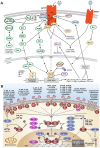STAT3: Key targets of growth-promoting receptor positive breast cancer
- PMID: 39468521
- PMCID: PMC11520424
- DOI: 10.1186/s12935-024-03541-9
STAT3: Key targets of growth-promoting receptor positive breast cancer
Abstract
Breast cancer has become the malignant tumor with the first incidence and the second mortality among female cancers. Most female breast cancers belong to luminal-type breast cancer and HER2-positive breast cancer. These breast cancer cells all have different driving genes, which constantly promote the proliferation and metastasis of breast cancer cells. Signal transducer and activator of transcription 3 (STAT3) is an important breast cancer-related gene, which can promote the progress of breast cancer. It has been proved in clinical and basic research that over-expressed and constitutively activated STAT3 is involved in the progress, proliferation, metastasis and chemotherapy resistance of breast cancer. STAT3 is an important key target in luminal-type breast cancer and HER2-positive cancer, which has an important impact on the curative effect of related treatments. In breast cancer, the activation of STAT3 will change the spatial position of STAT3 protein and cause different phenotypic changes of breast cancer cells. In the current basic research and clinical research, small molecule inhibitors activated by targeting STAT3 can effectively treat breast cancer, and enhance the efficacy level of related treatment methods for luminal-type and HER2-positive breast cancers.
Keywords: Breast cancer; Cell growth; Growth-promoting; Oncogene; STAT3; Small molecule inhibitors.
© 2024. The Author(s).
Conflict of interest statement
The authors declare no competing interests.
Figures





References
-
- Siegel RL, Giaquinto AN, Jemal A. Cancer statistics, 2024. Cancer J Clin. 2024;74(1):12–49. - PubMed
-
- Giaquinto AN, Sung H, Miller KD, Kramer JL, Newman LA, Minihan A, Jemal A, Siegel RL. Breast Cancer Statistics, 2022. Cancer J Clin. 2022;72(6):524–41. - PubMed
-
- Li T, Mello-Thoms C, Brennan PC. Descriptive epidemiology of breast cancer in China: incidence, mortality, survival and prevalence. Breast Cancer Res Treat. 2016;159(3):395–406. - PubMed
Publication types
Grants and funding
- TGD23H160004/Natural Science Foundation of Zhejiang Province
- 2023KY611/Science and Technology Program offered by the Health Bureau of Zhejiang Province
- 2019YFE0196500/National Key research and development program/International cooperation in science and technology innovation/key special projects of Hong Kong, Macao and Taiwan cooperation in science and technology innovation
LinkOut - more resources
Full Text Sources
Research Materials
Miscellaneous

